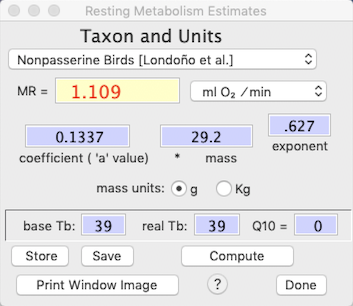
 |
Metabolic allometry; minimum flowrate
|
|
The initial popup menu contains some very generalized equations, and also allows you to switch to submenus for specific taxa (arthropods, fish, birds, mammals, etc.). For most taxa, several different equations are available (from different literature sources, which are described in the 'help' field to the right). You can also pick the desired output units. The energy equivalence of metabolism (joules per ml of oxygen consumed) can be set with the 'O2 heat equivalence' selection in the "Respirometry" submenu (EDIT menu); the default value is 20.1 joules/ml. The mass coefficient in the allometric equation ('a' value) is adjusted to reflect whatever output unit is in use. Results can be stored for later use.  Metabolism for all taxa are calculated from power functions:
Metabolism for all taxa are calculated from power functions:metabolism = a Mb (where a is the mass coefficient, M is mass, and b is the mass exponent)
This example shows an estimate of the resting metabolic rate (RMR) of
a 37.3 g bird, in units of ml O2/min.
The equation was derived from a paper published by Andrew Mckechnie and
Blair Wolf (Click here for a list of the references from which allometric equations were obtained.). The 'Store' button 'remembers' the computed metabolism for later use (for example in other calculators). The 'Save' button, if present, lets you save the current mass coefficient and mass exponent values for future use, accessed as 'Custom coefficent and exponent' option in the Taxon popup. The 'Save' button is accessible only if the units are set to ml O2/min. NOTE: you will have to click the 'Save Current Preferences' button in the Preferences window if you want to have your custom values available the next time you run the program.
|